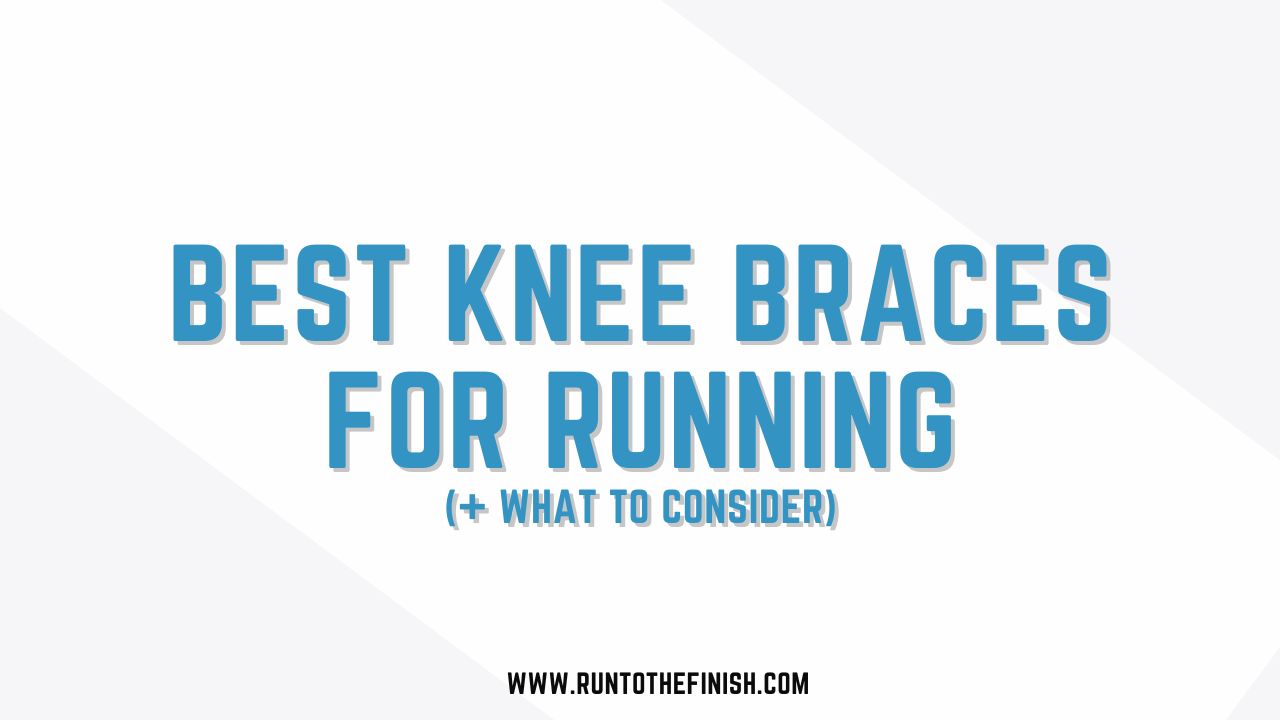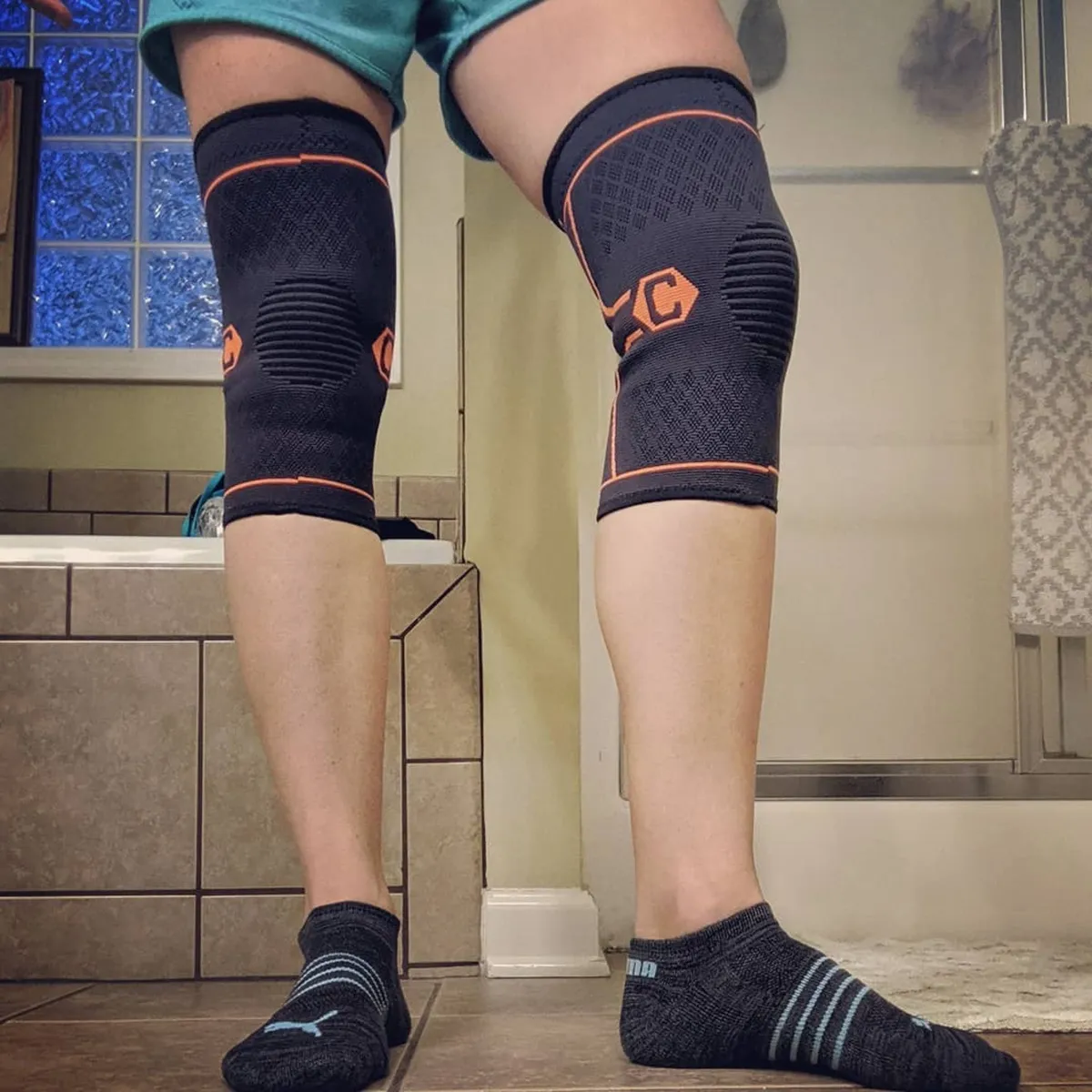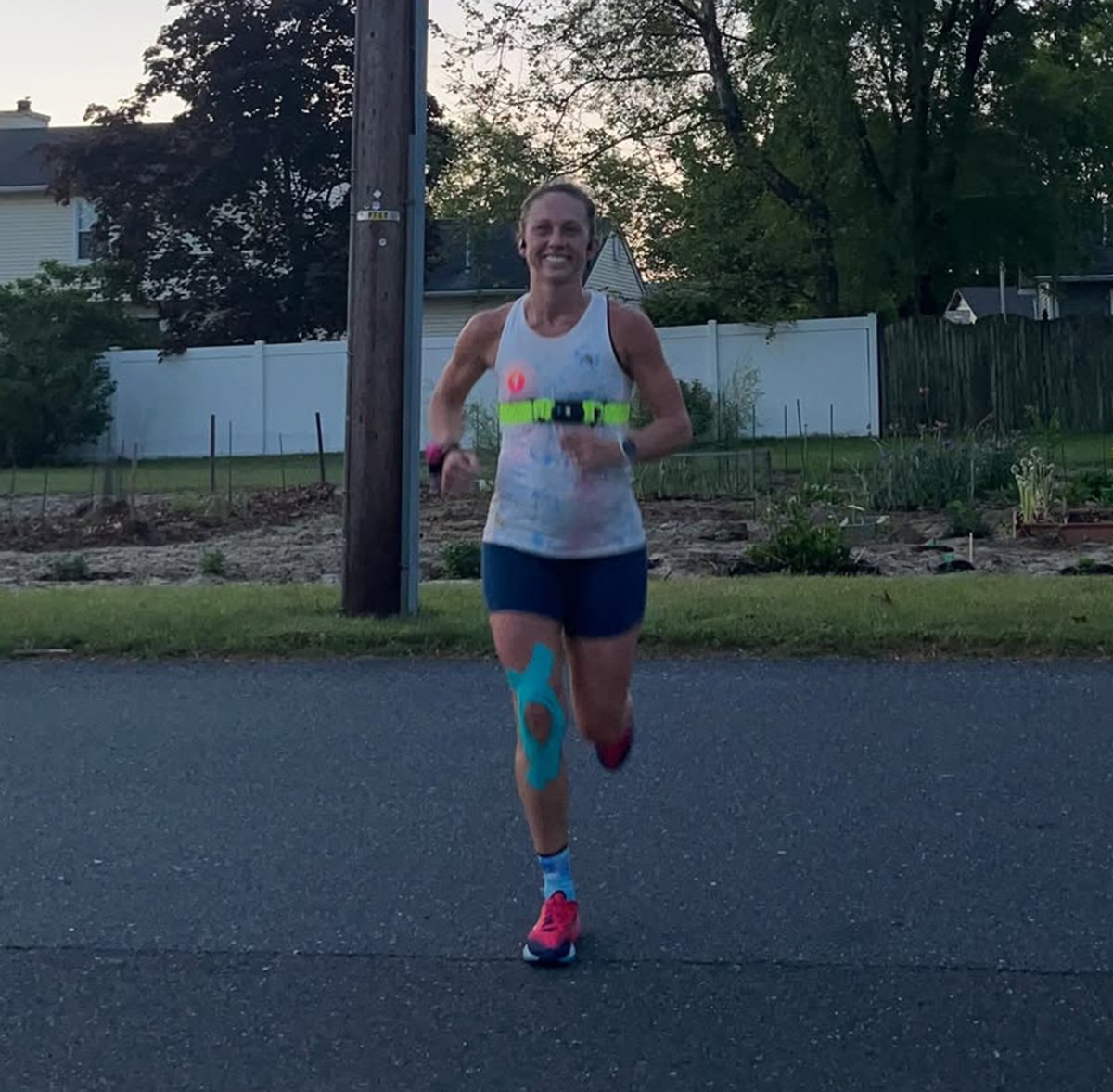A knee brace for running can be a helpful tool for runners, providing support and stability to the knee joint and helping to prevent or manage injuries.
Even though there is NO evidence that running is bad for your knees. Assuming you train smart and work on some form basics, it’s absolutely possible to run pain free.

If you’re training for a marathon or new to running a lot of miles, you may deal with a bout of knee pain every now and then.
I’ve talked in depth about the most common causes of running knee pain. You’ll see that for most we’re looking at working on hip, glute and core strength. But in the meant time, a little support can be useful.
Although significant knee injuries and chronic pain demand a trip to the doctor, mild knee pain and instability can often be treated at home. Usually, with some activity modification, increased strength work, reducing mileage, and possibly a knee brace.
There are a variety of knee braces available, each tailored to address particular knee issues. While some knee braces offer additional support and stability to the knee joint, others compress the knee, to minimize swelling and speed up healing.
Knee braces and knee sleeves help support the kneecap (patella) and the knee ligaments to keep the knee joint in the right place. Good alignment reduces stress and strain on the knee joint.
This can make the knee hurt less and keep it from getting hurt more while the injured tissues heal. (In recently dealing with jumper’s knee, I was taping for this very reasons. To keep my knee cap in a better position.)
They’re usually made of a mix of materials, like neoprene, elastic, nylon, and metal. These braces are worn around the knee to help reduce pain, swelling, and instability caused by injuries or medical conditions.

They can be used as a preventative measure to help reduce the risk of knee injuries when running. Or to help in relieving and alleviating pain from running knee injuries such as runner’s knee.
It’s important to understand the different types of knee braces available, as well as the factors to consider when choosing a knee brace for running. I share all of that and more in this complete guide to knee braces for running.
Types of Knee Braces
There are three main types of knee braces, and each can be used for different purposes. Let’s look at them in more detail:
1. Compression Sleeve Brace
A compression sleeve provides the least amount of support. These are the ones most runners look for first, and it’s usually safe to put them on when you have any kind of pain.
This type of brace is just a tight sleeve that goes around the joint. It keeps swelling from getting worse and helps the joint move better on its own.
Knee compression sleeves can be very restrictive, especially if they have metal stays or are made of thick material.
Generally, the brace needs to be tight and strong for the compression to work and ease knee pain. But, if your brace is to thick and restrictive, you may find it challenging to run. The wrong fit will limit the range of motion in your stride.
Because of this, it helps to think of compression knee braces for running as belonging to one of two types. The first type is light compression knee braces, which are made for runners with mild pain. These knee braces should not get in the way of running too much.
The second type consists of moderate to strong compression knee braces, in which knee pain alleviation is the priority. For that, you’re willing to make concessions to your running technique are necessary to get pain relief.
2. Patellar Stabilizers
The patellar brace is the next level of support. It helps the kneecap, that is the patella, move in a straighter direction and takes pressure off the tendon.
It’s similar to a sleeve, but the part that presses on the kneecap is thicker. They are frequently used for patellofemoral pain and problems with the patellar tendon.
Also, if the middle part of the front of your knee hurts, you might want to try a patellar counterforce brace, which puts pressure on that tendon.
3. Medial/Lateral Support Brace
Medial/lateral support braces provide the highest level of support. They have sturdy hinged sections that keep the knee from caving in and out.

They are worn to prevent sprains and tears to the knee’s ligaments, specifically the medial and lateral collateral ligaments. Moreover, they safeguard the ACL against rotational forces. These are the bulkiest types of knee braces for running and are usually made of hard plastic and have straps.
Also, this brace is suitable to relieve stress on the medial or lateral meniscus following injury, surgery, or arthritis. They are often used to treat knee injuries such as meniscus tears, patellar tendonitis, and patellar subluxation.
5 Best Knee Braces For Running
Bodyprox Dual Patellar Support Strap – Patellar Pain
The BODYPROX Dual Patella Tendon Support Strap is an excellent option if you need a little bit more stability and support from your knee brace than a straightforward knee strap.
Lightweight and improving upon the traditional knee strap design, this running knee brace provides additional structural support in the area above and below the knee.

Many runners find that this dual strap system is more efficient at reducing knee pain while running since it enhances support for good quadriceps and kneecap tracking. But I found it uncomfortable, so this is where you have to play with what’s a right thing for you.
It’s one of the best knee braces for running because it’s still very light and unrestrictive. This is particularly true if you need a little bit more support for patella tendinitis or bursitis than a single knee strap can offer but don’t want to be constrained by a compression sleeve or multi-strap knee brace.
- Sizes: S, M, L
- Type: Adjustable strap with compression
- Colors: 1 available
- Available from Amazon.com for $12.75
NEENCA Professional Knee Brace – Comfy, Strong Support
When you need just a little extra help from your knee support while running, the NEECA Knee Compression Sleeve is the way to go.
This knee brace offers additional support and compression than thinner, more basic knee sleeves while remaining lightweight and reasonably flexible like other knee sleeves.

Most knee sleeves are simple pull-on wraps made of elastic, spandex, or Lycra. However, the NEENCA Knee Compression Sleeve has built-in side stabilizers and a unique gel pad that goes around the patella to provide extra support and stability.
David has been running in something similar and sizing is extremely important. Occasionally, he would find it pinching along the back of his knee. Which was likely because it was bunching up from being a tad too big.
There is a patented gel pad that spreads pressure and aligns the patella. There are also metal side stabilizers that give the sleeve stability on the side.
The combination of the highly elastic fabric and the silicone straps makes for an excellent knee brace for runners in need of a bit more support and squeeze to minimize inflammation.
The knit pattern makes the knee brace breathable and moisture-wicking, so it doesn’t get too sweaty when you work out, and you can wash it when you’re done.
- Sizes: XS-XXXL
- Type: Compression Sleeve
- Colors: 11 available
- Available from Amazon.com for $21
IPOW Knee Pain Relief and Patella Stabilizer Strap Brace – Patellar Pain
A simple knee strap may be all that is needed to offer the required stability to the knee and ease pain for those who suffer from runner’s knee, IT band syndrome, or patella tracking difficulties.
Knee straps help stabilize and align the patella, which makes the knee less painful and restores its function.

This is why they are often the best type of knee brace for runner’s knee, a painful condition in which the kneecap (patella) moves in an abnormal way along the femur, causing pain.
When you’re using the IPOW Knee Pain Relief & Patella Stabilizer Knee Strap Brace, you won’t have to worry about having to modify your running style. The knee straps appear to maintain their position better than those offered by competitors, and are flexible enough to be used regularly.
- Sizes: One size fits most
- Type: Adjustable strap
- Colors: 7 available
- Available from Amazon.com for $10
CAMBIVO Knee Compression Sleeve – Thick Compression
The Cambivo Knee Compression Sleeve is made of 65% nylon, 20% latex, and 15% spandex and offers the ideal amount of compression and support while remaining incredibly light and breathable.
This knee sleeve’s style enhances the conventional compression sleeve style. It boasts innovative, flexible 3D knitting technology that offers steady pressure to stabilize and support your knee while distributing painfully high loads equally over the knee joint.

The Cambivo sleeve is great for running due to the anti-slip silicone strips that are woven into the material. Moreover, it offers just the right amount of insulation to improve circulation and lessen stiffness without being excessively warm.
- Sizes: SM-XXXL
- Type: Compression sleeve
- Colors: 8 available
- Available from Amazon.com for $13.60
Bracoo Adjustable Knee Compression Brace – Easily Adjustable
The Bracoo Adjustable Knee Compression Brace is a great option if you’re looking for a lightweight knee brace that won’t put pressure on your patella or restrict your range of motion. It is an excellent choice for runners with osteoarthritis and generally sore knees.
The perforated neoprene used to make the brace allows air to circulate, which in turn reduces sweating and itching while yet keeping the knee warm and promoting blood flow.

With its open patella design, the knee brace won’t slip off while you’re on the move. A stabilizing ring that surrounds the whole patella area provides compression and stability.
The three-strap system on this knee brace is a good feature because it makes it easy to adjust the fit and spreads loads and pressures evenly across all the ligaments and structures in the knee joint. This helps to reduce pinpoint pain.
- Sizes: One size fits most
- Type: Adjustable compression sleeve/wrap
- Colors: 3 available
- Available from Amazon.com for $13.50
Factors to Consider When Buying a Knee Brace for Running
When shopping for a knee brace for running, there are several factors to consider. These include:
Type of Brace
Knee sleeves are a popular choice for runners as they provide mild support and compression to the knee joint, which can help reduce swelling and inflammation. They’re also cheaper and pretty easy to find.
However, if you have a more serious injury or condition, a hinged or medial brace may be more appropriate as they offer more support and stability to the knee.
Size and Fit
It is important to measure your knee circumference to ensure a proper fit. Most knee braces come in different sizes and have adjustable straps or closures to provide a customized fit. A properly fitting brace should not slip or move around during exercise.
Material
Neoprene is a popular material for knee sleeves as it is durable and provides good compression. However, it can be hot and uncomfortable for some runners.
Elastic and nylon materials are lightweight and breathable but may not offer as much compression as neoprene.

Flexibility
Look for a knee brace that allows for a natural range of motion, as this will help prevent discomfort and restriction of movement while running. A lightweight and flexible brace will also be less bulky and more comfortable to wear.
Level of Support
The level of support you need will depend on the severity of your injury or condition. Mild sprains may only require a sleeve or compression brace, while more severe injuries may require a medial, hinged, or patellar knee brace to provide additional stability.
And, of course, it is always recommended to consult with a healthcare professional before purchasing a knee brace for running. A doctor or physical therapist can assess your condition and provide guidance on the type of brace that is most appropriate for your needs.
What Else Can Runners Use as a Knee Brace For Running?
A popular and really useful alternative to traditional knee braces is using kinesiology tape for knee pain. Kinesio taping makes use of a stretchy elastic adhesive developed in Japan.
This was my savior prior to and after knee surgery in 2017 due to a trampoline incident.
It’s now what I recommend more than using a brace for many of our athletes. I find it easier to move and easier to ween yourself off of it.
This tape increases the space between blood arteries and cells by lifting the skin. This reduces discomfort, increases soft tissue drainage, and allows tissue to move more smoothly over muscles. Plus, taping can also help stabilize joints that have ligament damage.

Using kinesiology tape is a great alternative to knee braces, thanks to its numerous benefits. It not only helps improve blood flow but also increases lymphatic drainage and can provide joint support.
What’s best is that it doesn’t impede your range of motion.
This means that while wearing the tape, there isn’t anything that’ll hinder you like a brace or sleeve can while you’re trying to run or move. It’s going to move with you and allow you to target where you need support, rather than all around the knee.
Check out my posts to learn how to use kinesiology tape for swelling or to learn how to properly use knee tape for stability.
The two best brands for sticking: Rock Tape and KT Tape.
When Should Runners Not Wear a Knee Brace?
A knee brace for running won’t fix all lower-body problems, and there are times when you shouldn’t use one as a runner.
It’s best to see a doctor to be sure nothing more serious is going on if you have an acute knee injury or trauma, such as a fall or a knee twist. If your knee keeps swelling, you can’t fully bend or straighten it, or the pain gets worse as you run and doesn’t go away when you warm up, you should see a doctor.
Also, you shouldn’t use a brace just because you want to.
As a person begins to wear a brace, the structures it is meant to preserve deteriorate progressively, and the person becomes increasingly dependent on the brace over time.
If a brace is worn when it is not necessary, it will just amplify muscle deficits more and may even cause weakness where none previously existed.
Gaining the strength, mobility, and control necessary to run safely without a brace is a more effective method of injury and pain prevention.
All right, hopefully this recap of some different knee braces for running gives you a place to start and see what might work. Just remember not to try and cover up knee pain! Find the root cause.
Looking for additional tips?
- Best Running Shoes for Knee Pain
- 30 Day Core Program for injury prevention
- Knee Strengthening Exercises for Runners
Other ways to connect with Amanda
Instagram Daily Fun: RunToTheFinish
Pinterest to find more Running Tips: RunToTheFinish



 11 Best Fall Marathons in the United States
11 Best Fall Marathons in the United States